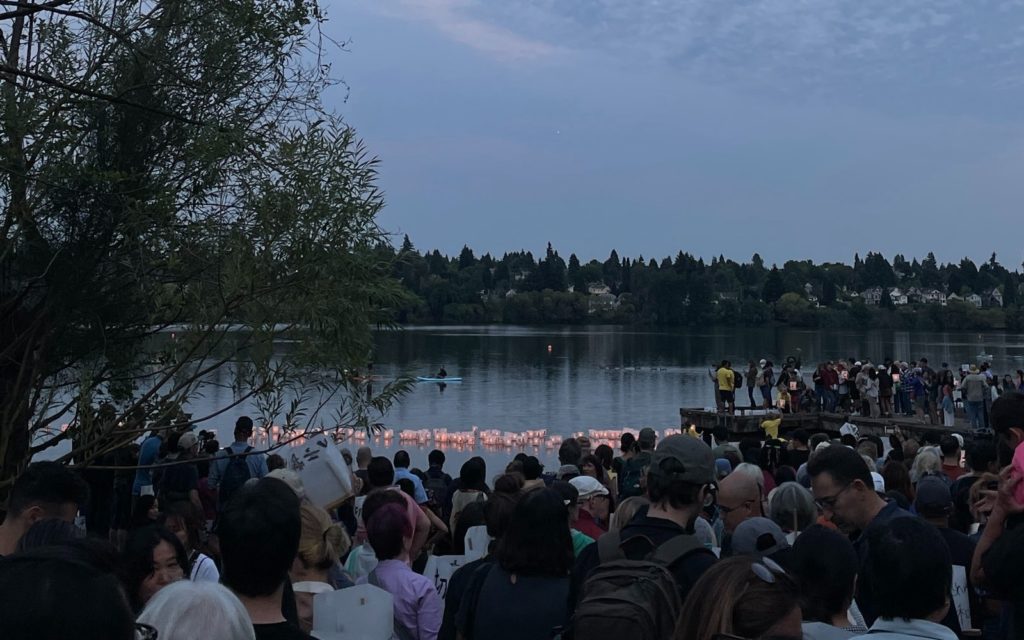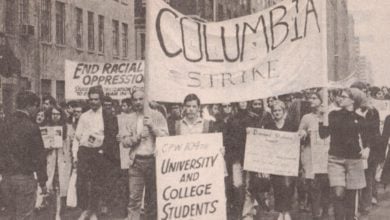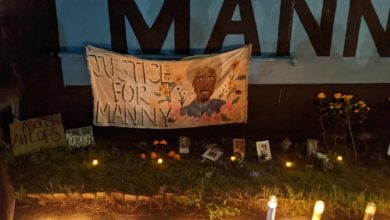On August 6, the anniversary of the first atomic bombing of the Japanese city of Hiroshima, a crowd of hundreds gathered at Seattle’s Green Lake Park to pay tribute to the victims of the U.S. atomic bombings and all victims of nuclear testing and war, including the people of the Marshall islands and Indigenous and poor communities in New Mexico. The crowd was diverse, with antiwar activists, wide-ranging faith communities and leaders, descendents of Hibakushas (loan word from Japanese, 被爆者, meaning “survivor of the bomb”), families, veterans, and cultural performers, all united in their demand to abolish nuclear weapons starting right here in the United States.
The memorial was organized by From Hiroshima To Hope, which since 1984 has hosted an annual commemoration for victims of nuclear bombings and war. After hearing from several speakers and cultural performances, the memorial culminated in a toro nagashi, a lantern floating ceremony, led by a procession of peace activists.
Washington state is a key player in nuclear bomb industry
It is worth noting the particular role that Washington state plays in the U.S. government’s history and continuing usage of nuclear weapons. As the director of the Nuclear Information Project at the Federation of American Scientists, Hans M. Kristensen, has said of Washington state, it “has been at all levels a cornerstone of the U.S. nuclear enterprise.”
Just to give an initial figure, the Puget Sound area itself contains around a third of the country’s nuclear weaponry. As put by Stan Shikuma at From Hiroshima To Hope, if Washington were to secede from the United States, it would be the fifth largest nuclear power on the globe. Not just in scale, Washington is also intimately involved in the entire process of nuclear weapon production, with the Institute of Shock Physics at the Washington State University in Pullman, Washington, contributing to computer simulations of the U.S. nuclear stockpile, the Pacific Northwest Laboratory assuring tritium production (a key chemical for contemporary nukes), the Bangor submarine base housing nuclear warheads, and so on. Further, the I-5 corridor between Tacoma and Olympia is home to the 62nd Airlift Wing at Joint Base Lewis-McChord — the only unit in the country capable of transporting a nuclear bomb. Aside from the state’s involvement in the entire pipeline of nuclear weaponry, from research to deployment, a key site in the Manhattan project was also located here.
Southeast of the Puget Sound area in central Washington is the Hanford site, which produced the plutonium used in the bomb dropped on Nagasaki and in the Trinity nuclear test. Hanford’s involvement in plutonium production didn’t end there, with the Cold War extending operations until the 1970s. The production process, however, was such that the waste removal of toxic byproducts was mismanaged and led to Hanford today being one of the most contaminated sites in the country. Many workers who unknowingly contributed to the WWII and Cold War-era plutonium production as well as current day residents now suffer illnesses stemming from exposure.
The danger of nuclear conflict and a call for a militant antiwar movement
In the contemporary landscape of an official U.S. military strategy of “Great Power Conflict,” meaning orienting towards war with China and Russia, the danger of nuclear conflict is moving closer. Instead of taking steps to de-escalate and disarm, just like previous presidents, President Biden has maintained the long-standing refusal to rule out using nuclear weapons against non-nuclear threats and first usage of nuclear weapons. This means that the United States reserves the right to use nukes even if it has not been the target of a nuclear attack or if the target does not have nuclear weapons. Additionally, since the early 2000s, the United States has continued to withdraw from major nuclear and missile treaties aimed at worldwide deterrence. Starting in 2002, under President Bush, the United States left the Anti-Ballistic Missile Treaty; in 2019, the United States withdrew from the Intermediate-Range Nuclear Forces Treaty, and in 2020, left the Treaty on Open Skies. The departure from major treaties only gives more ammunition to U.S. imperialist policies and the potential for nuclear catastrophe.
The only way to assure that there is a tomorrow without nuclear weapons and the threat of nuclear war is the revival of a coherent and vocal antiwar movement that is represented across the country that demands the abolition of nuclear weapons without compromise.
Read more: Why the U.S. dropped nuclear bombs on Hiroshima and Nagasaki






